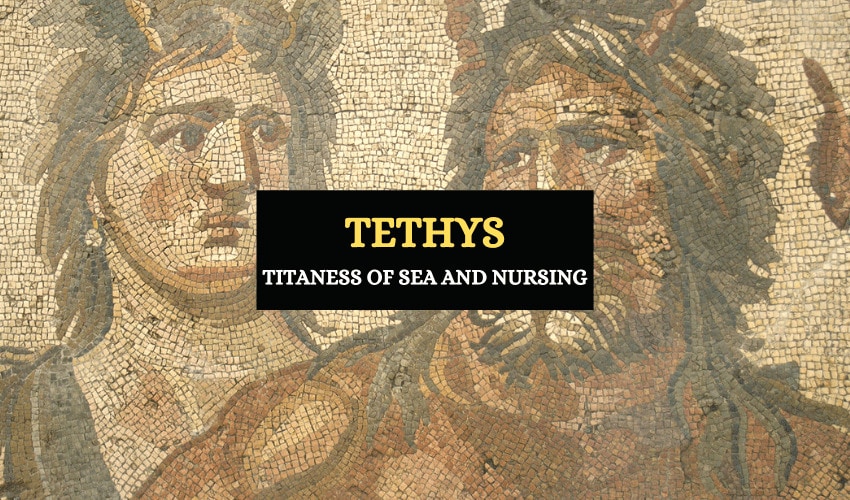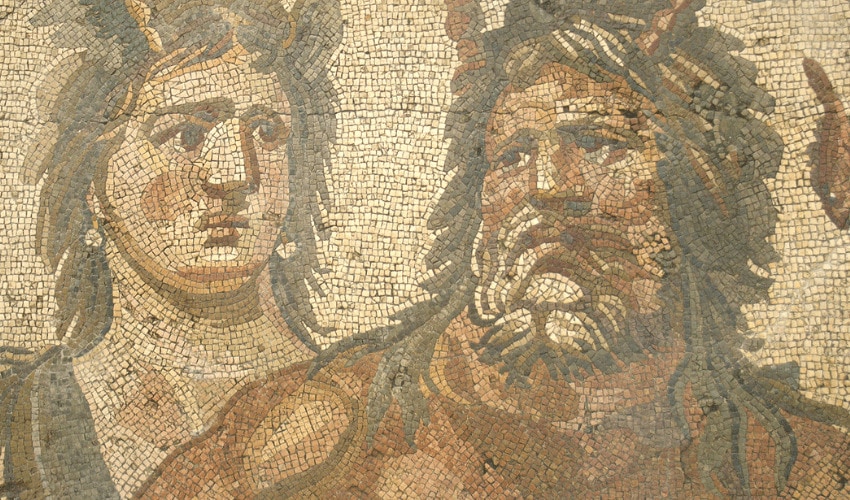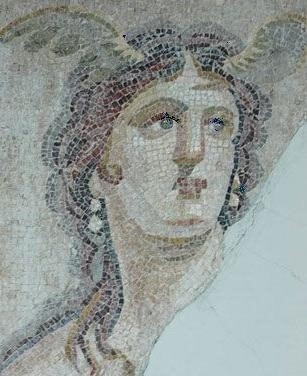
Table of Contents
In Greek mythology, Tethys was a Titan goddess and the daughter of the primordial deities. The Ancient Greeks referred to her as the goddess of the ocean. She had no established cults and wasn’t considered a prominent figure of Greek mythology but she did play a part in some of the myths of others. Let’s take a closer look at her story.
Who Was Tethys?
Tethys was born to the primordial god Uranus (the god of the sky) and his wife Gaia (the personification of the earth). Being one of the twelve original Titans, she had eleven siblings: Cronus, Crius, Coeus, Hyperion, Oceanus, Iapetus, Rhea, Phoebe, Mnemosyne, Themis and Theia. Her name was derived from ‘tethe’ the Greek word meaning ‘grandmother’ or ‘nurse.
At the time of her birth, Tethys’ father Uranus was the Supreme god of the cosmos but because of Gaia’s plotting, he was overthrown by his own children the Titans. Cronus castrated his father with an adamantine sickle and having lost most of his powers, Uranus had to return to the heavens. Tethys and her sisters, however, played no active role in the rebellion against their father.
Once Cronus took his father’s place as the Supreme deity, the cosmos was divided amongst the Titans and each god and goddess was given their own sphere of influence. Tethys’ sphere was water and she became the goddess of the sea.
Tethys’ Role as a Mother

Although Tethys was called the Titan goddess of the sea, she was actually the goddess of the primal font of fresh water that nourishes the earth. She married her brother Oceanus, the Greek god of the river that encircled the entire world.
The couple had an extremely large number of children together, totaling six thousand, and they were known as the Oceanids and the Potamoi. The Oceanids were goddess-nymphs whose role was to preside over the earth’s sources of fresh-water. There were three thousand of them.
The Potamoi were the gods of all the streams and rivers of earth. There were three thousand Potamoi just like the Oceanids. Tethys’ supplied all her children (the water sources) with the water drawn from Oceanus.
Tethys in the Titanomachy
The ‘Golden Age of Mythology’, the rule of Tethys and her siblings, came to an end when Cronus’ son Zeus (the Olympian god) overthrew his father just like Cronus had overthrown Uranus. This led to a ten-year-long water between the Olympian deities and the Titans known as the Titanomachy.
While the majority of the Titans stood against Zeus, all the females including Tethys were neutral and didn’t take sides. Even some of the male Titans like Tethys’ husband Oceanus, didn’t take part in the war. In some accounts, Zeus handed his sisters Demeter, Hestia and Hera over to Tethys during the war and she took care of them.
The Olympians won the Titanomachy and Zeus took up the position of the Supreme deity. All of the Titans who had fought against Zeus were punished and sent to Tartarus, the dungeon of torment and suffering in the Underworld. However, Tethys and Oceanus were hardly affected by this change since they hadn’t taken any sides during the war.
Although Zeus’ brother Poseidon became the god of the world’s water and the king of the Potamoi, he didn’t infringe into Oceanus’ domain so all was well.
Tethys and the Goddess Hera
Hera was in Tethys’ care during the war, but according to a less common tale, Tethys nursed Hera as a new-born. In this version of the story, Hera was hidden away (just like Zeus was) so that her father Cronus couldn’t swallow her like he did her siblings.
According to various sources, Tethys and Hera had a strong bond. When Hera found out that her husband, Zeus, was having an affair with the nymph Callisto, it was to Tethys that she went for advice. Callisto was transformed into the Great Bear constellation and placed in the sky by Zeus for her own protection. Tethys forbade her to bathe or drink in the waters of Oceanus. This is why the Great Bear constellation continues to circle the North Star and never falls below the horizon.
Tethys and the Trojan Prince Aesacus
As mentioned in Ovid’s Metamorphoses, the goddess Tethys appeared in the story of Aesacus, in which she played an important role. Aesacus was the son of the Trojan King Priam and was gifted with the ability to see the future. When Priam’s wife Hecuba was pregnant with Paris, Aesacus, knowing what was to come, told his father of the destruction that Paris would bring upon the city of Troy.
Aesacus fell in love with the Naiad-nymph Hesperia (or Asterope), the daughter of the Potamoi Cebren. However, Hesperia stepped on a poisonous snake which bit her and she was killed by its venom. Aesacus was devastated at the death of his lover and threw himself off a tall cliff into the sea in an attempt to kill himself. Before he hit the water, Tethys transformed him into a diving bird so that he didn’t die.
Now in the form of a bird, Aesacus tried again to jump to his death from the cliff but he neatly plunged into the water without hurting himself. It’s said that even today, he remains in the form of the diving bird and continues to plunge from the top of the cliff into the sea.
Representations of Tethys

Before the Roman period, representations of the goddess Tethys were rare. She appears on a black-figure painted in the 6th century BC by the Attic potter Sophilos. In the painting, Tethys is depicted following her husband, walking at the end of a procession of deities who had been invited to the wedding of Peleus and Thetis.
During the 2-4th centuries AD, the image of Tethys was frequently depicted on mosaics. She is identified by the wings on her brow, a ketos (a sea monster with the head of a dragon and body of a snake) and a rudder or oar. Her winged brow became a symbol closely associated with Tethys and it signified her role as the mother of the rain clouds.
In Brief
Tethys wasn’t a major goddess in Greek mythology. However, while she didn’t have an active role in most of the myths, she was still an important figure. Many of her children went on to play a part in some of the most famous and memorable stories of Greek mythology.








